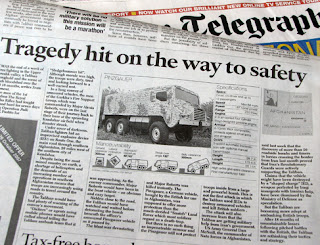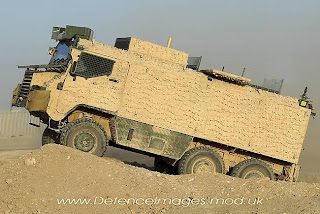 Major Alexis Roberts, we now learn, courtesy of The Sunday Telegraph died in a Pinzgauer Vector, a vehicle we have consistently condemned as being dangerously vulnerable to mines and IEDs.
Major Alexis Roberts, we now learn, courtesy of The Sunday Telegraph died in a Pinzgauer Vector, a vehicle we have consistently condemned as being dangerously vulnerable to mines and IEDs.Small wonder, therefore – as we noted yesterday - that the MoD failed in any of its official announcements on the death of Major Roberts to identify the type of vehicle in which he was travelling.
Some information must have leaked out, however, as The Daily Mail - alone of all the news media – did note in yesterday's edition (albeit in a down page item) that he (Major Roberts):
… died when a booby-trap bomb blasted his armoured vehicle as his troops were returning to their main base in Kandahar, following days of fierce fighting against the Taliban in neighbouring Helmand Province. The Vector armoured truck was one of a fleet purchased specially by the MoD last year to provide extra protection for troops in Iraq and Afghanistan, but its armour proved too weak to protect the soldiers inside.
 But, in what bears all the hallmarks of a damage limitation exercise, the MoD - through defence correspondent Sean Rayment in a separate article in The Sunday Telegraph - places an apologia for the vehicle, so bland in its description that no ordinary person would begin to realise that something was badly amiss.
But, in what bears all the hallmarks of a damage limitation exercise, the MoD - through defence correspondent Sean Rayment in a separate article in The Sunday Telegraph - places an apologia for the vehicle, so bland in its description that no ordinary person would begin to realise that something was badly amiss.The online edition of Rayment's story is, in fact, headed: "Blast fuels fears Iran is involved," thus diverting attention away from the fatal weaknesses of the Vector, that headline having no more substance than a comment in the text, that: "The attack will also increase fears that the Taliban are getting military help from Iran's government."
As to the attack, Rayment tells us that:
In a long convoy of armoured vehicles, the men of the Gurkha's Fire Support Group, which was commanded by Major Alexis Roberts, were on the last stage of their journey back to their base at the sprawling Kandahar air field when disaster struck.With that background, Rayment is then at pains to tell us that:
Under cover of darkness, Taliban fighters hid an improvised explosive device (IED) on Route One, the main road through southern Afghanistan, 20 miles west of the southern city of Kandahar.
Despite being the most mined country on earth, a shortage of helicopters and the demands of an increasing number of operations in southern Afghanistan means that troops are increasingly using roads to travel around the country.
The Taliban would have had plenty of warning of the convoy's movement. "Dickers" or agents using mobile phones would have called ahead telling the Taliban ambush team that it was approaching. As the convoy commander, Major Roberts would have been in the front vehicle – an obvious and easy target.
Hidden close to the road, the Taliban would have watched and waited before detonating the bomb beneath the officer's armoured Pinzgauer vehicle as it passed by. The blast was devastating and Major Roberts was killed instantly.
The Pinzgauer, a German vehicle, bought by the British for use in Afghanistan, was supposed to offer more protection than the much-derided "Snatch" Land Rover which most soldiers regard as a death-trap.And therein is the subtle, but mendacious propaganda – apart from the factual errors which makes one really wonder about the capability of a man who calls himself a "defence correspondent". The Pinzgauer is not and never has been German. It was originally an Austrian design but the company has since been bought out and is now owned by BAE Systems and the vehicles are manufactured in Guildford.
But there is no such thing as impenetrable armour and the Pinzgauer will not protect troops inside from a large and powerful bomb. This is not the first attack in which the Taliban used IEDs to destroy armoured vehicles and kill British soldiers.
 The real "error" though is the assertion that "the Pinzgauer will not protect troops inside from a large and powerful bomb" – what is known as a "true lie". For sure, it will indeed not protect troops from "a large and powerful bomb" – but it will not protect troops from a small bomb either. The Vector, in this respect, is less well-protected than the Land Rovers they are replacing (see left - this Land Rover "wolf" took a mine hit, yet the crew survived uninjured - because the front seating is over the wheel arch, in the Pinzgauer the crew would not survive even this modest blast).
The real "error" though is the assertion that "the Pinzgauer will not protect troops inside from a large and powerful bomb" – what is known as a "true lie". For sure, it will indeed not protect troops from "a large and powerful bomb" – but it will not protect troops from a small bomb either. The Vector, in this respect, is less well-protected than the Land Rovers they are replacing (see left - this Land Rover "wolf" took a mine hit, yet the crew survived uninjured - because the front seating is over the wheel arch, in the Pinzgauer the crew would not survive even this modest blast).What Rayment has done though, is plant the seed: it was "a large and powerful bomb" – no one could have survived it. Therefore, no one is to blame - even if this flies in the face of the evidence.
From what we know, the Pinzgauer Vector carries a crew of 4-5 troops (typically five). We know from the official reports that Major Roberts was killed and two others were injured. The likelihood is – unstated – that there were others in the vehicle who escaped uninjured. Either way, had this been "a large and powerful bomb", no one would have survived - as we have seen from other incidents.
 The reasonable and entirely sound inference, therefore, is that – as we did point out yesterday – had Major Roberts been in a better-protected vehicle (such as this Canadian RG-31, from which the crew escaped uninjured), he would have survived this attack.
The reasonable and entirely sound inference, therefore, is that – as we did point out yesterday – had Major Roberts been in a better-protected vehicle (such as this Canadian RG-31, from which the crew escaped uninjured), he would have survived this attack.We know this. The MoD almost certainly knows this – and from the number of e-mails and comments I have received today – a lot of people are of the same view. That makes it all the more essential, of course that the MoD diverts attention from its own negligence in buying the vehicles in the first place – amounting, we aver, to corporate manslaughter.
And, with other newspapers willing – albeit sporadically – to address to issue of inadequate vehicles (see: here, here and here), how necessary it is for the MoD to have "useful idiots" like Rayment to cover up what, on the face of it, was yet another avoidable death.
COMMENT THREAD